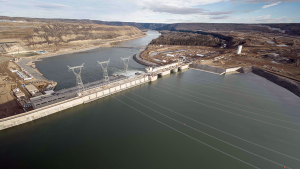A consulting engineering firm is developing conceptual design options for permanent river flood protection in vulnerable neighbourhoods along the Bow and Elbow rivers in Calgary.
A consulting engineering firm is developing conceptual design options for permanent river flood protection in vulnerable neighbourhoods along the Bow and Elbow rivers in Calgary.
“This is the first study to look at what is feasible, as well as what isn’t and to prioritize the options,” said Frank Frigo, senior planning engineer with the City of Calgary’s water resources department.
“After the flood, many flood mitigation measures have been contemplated, including additional storage and diversion using pipelines. However, we need a basis to compare what is technically feasible to determine the best way forward.”
Frigo said Associated Engineering was awarded a contract in October, 2013 to identify areas subject to flooding, and prepare conceptual designs with cost estimates for new flood mitigation structures or upgrades to existing ones.
“We did a whole lot of technical work based on the flood in 2005 and developed a response plan, which included modeling and inundation mapping to show areas where there could be an impact,” he said.
“But, we wanted to put permanent infrastructure in place and look at the feasibility of berms, flood wall and water cut off measures.”
The conceptual designs for permanent flood protection will be prioritized based on life cycle cost and benefit analysis.
Frigo said Calgary already has a fair amount of existing flood mitigation infrastructure in place, so there is a need to make sure long-term maintenance expectations are met.
This analysis will also identify the environmental, regulatory, land-use, access, aesthetic or other project interdependencies of the proposed flood protection works.
In addition, Northwest Hydraulic Thurber is undertaking a related study of the ice regime of the Bow River within Calgary.
The study will update understanding of local ice processes and conceptually identify monitoring and abatement options to address ice-driven flooding, safety and operational risks.
Recommendations for a monitoring program will be developed to better characterize and respond to the river ice regime, which will include observations of the 2013 and 2014 ice season.
“For a lot of people, the flood was an eye opener, but as engineers and hydrologists we knew that this was a possibility,” said Frigo.
The Alberta government hired three major engineering firms in January to study flood mitigation options for the Athabasca and Red Deer rivers.
The consortium of Golder Associates and IBI Group will provide an engineering assessment of flood mitigation options and recommendations for the Athabasca River basin.
Stantec Consulting Ltd. will provide an engineering assessment and recommendations for flood mitigation options for the Red Deer River basin.
These assessments will work within the same parameters as those already in progress for the Highwood, Elbow, Sheep, Bow, Oldman, and South Saskatchewan river basins.
In this case, AMEC and AECOM were hired by the Southern Alberta Flood Recovery Task Force to assess flood mitigation sites.
These studies will assess the feasibility of proposed flood reduction projects and the impacts on the overall watershed including:
— risk reduction structure types and locations;
— area accessibility;
— impacts on property values;
— relocation of utilities;
— environmental impacts; and,
— community preferences.
The consultants will assess various flood mitigation alternatives, the overall impacts of each alternative, and submit their findings on reducing the impact of future floods.
The dollar value of the contract was not released.
However, these contracts are schedule to be completed by March 31, 2014.
There is the possibility of an extension of up to six months.
The floods which began on June 20, 2013 impacted more than 100,000 Albertans in 30 communities.
According to a study commissioned by Alberta Transportation in 2001, the three largest known floods in Calgary all occurred before 1911, in 1879, 1897 and 1902.
The fourth highest flood in Calgary happened in 1932.
Since 1932, there have been no storms of any significance causing flooding until 2005 and 2013.










Recent Comments
comments for this post are closed